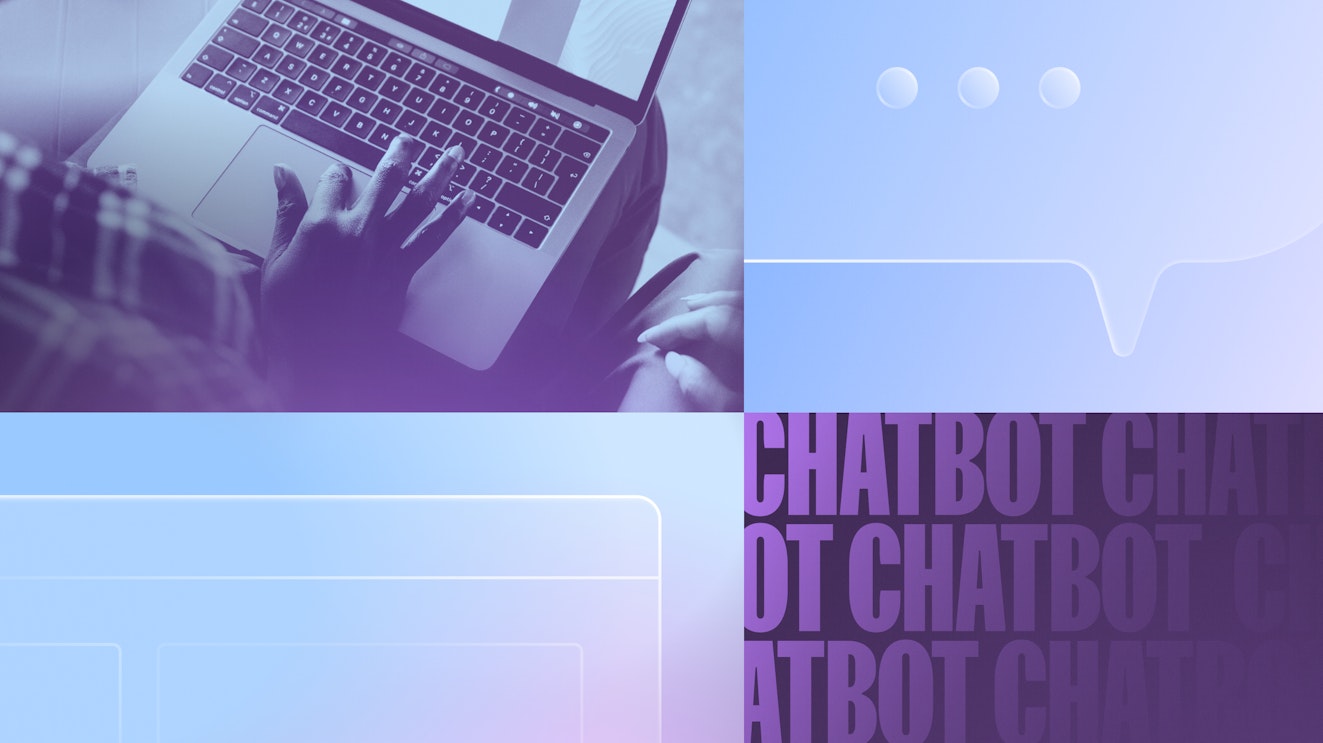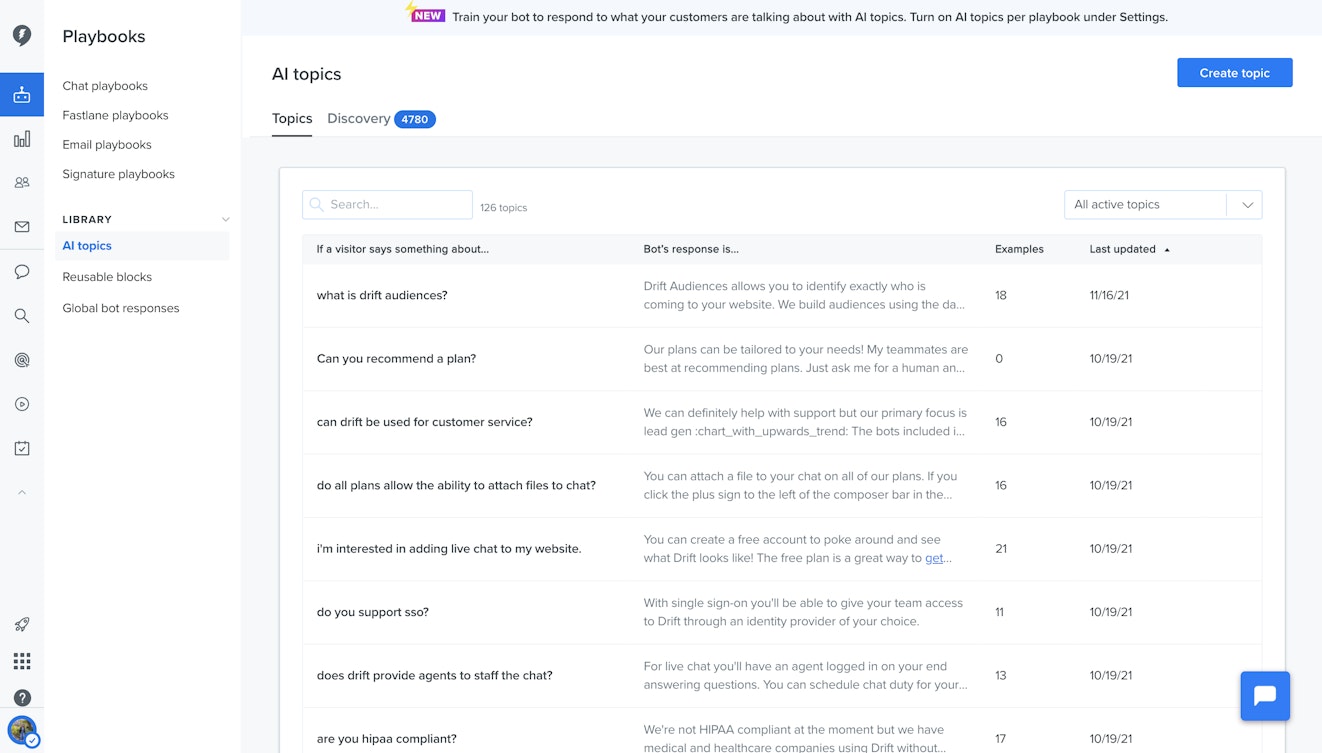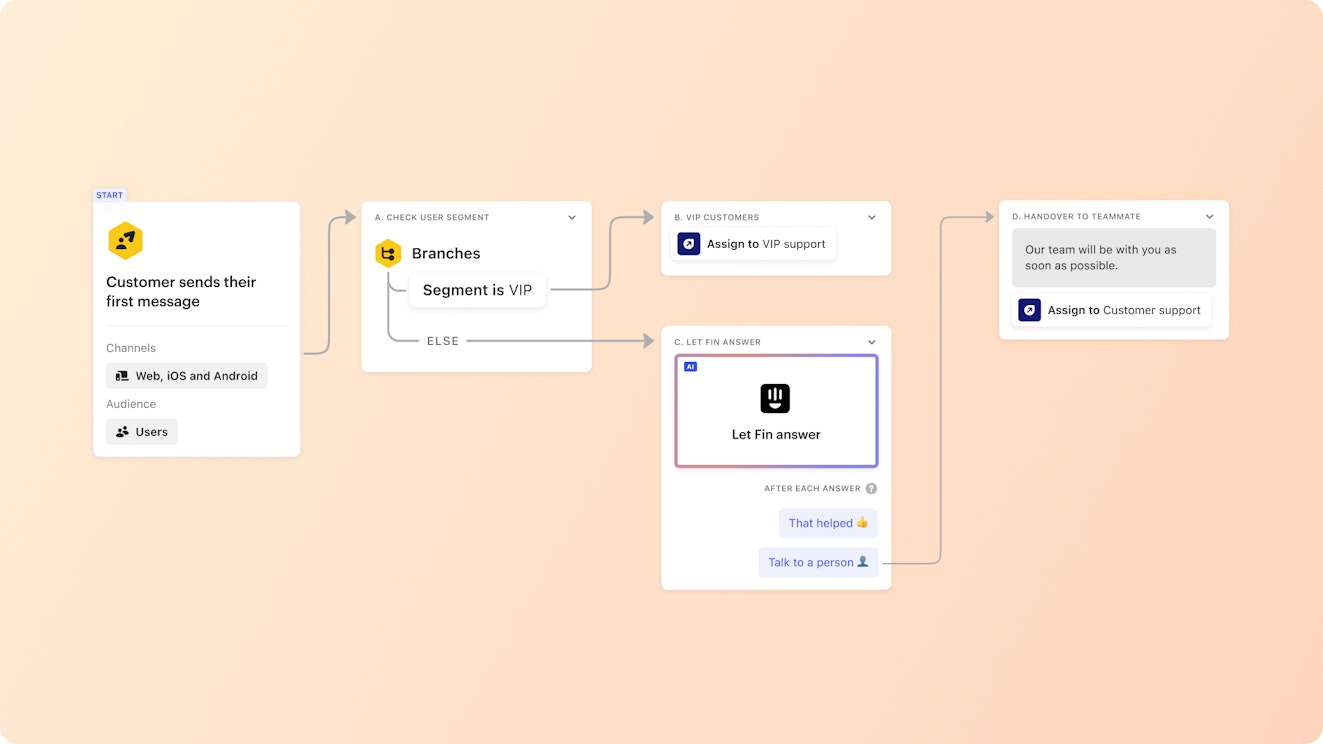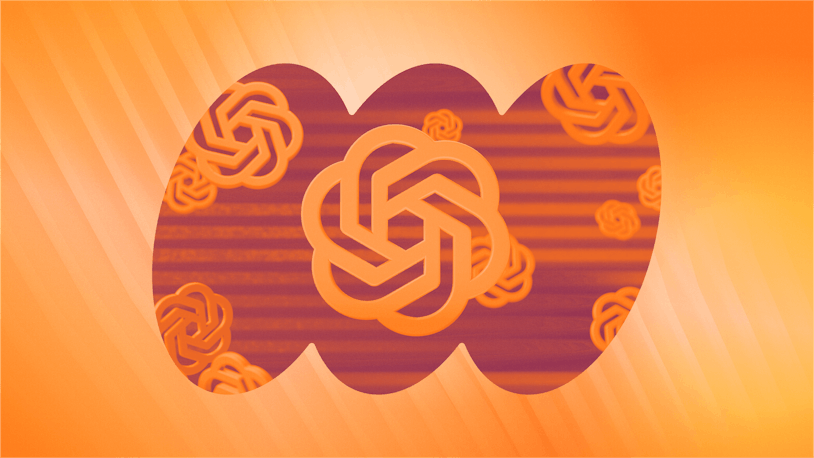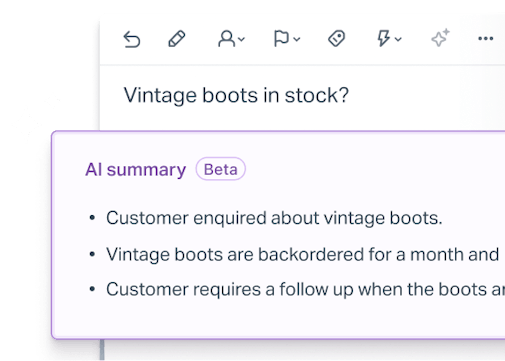Over the past few years it seems like nearly every software product on the planet has added an AI component. Outside of simply being a buzzy topic in the industry, the vast improvements to AI technology have turned it into a tool with a lot of different potential business uses.
Even though AI has exploded as of late, there are some parts of business that have long served as something of a testing ground for AI technology. One such area is customer service. Historically, AI was used as something of an assistant for live agents — a way to help them be more efficient. However, with the advancements in AI over the past few years, the applications have continued to grow, and one of the most interesting new use cases is AI live chat.
What is AI live chat?
AI live chat software is a tool that uses natural language processing (NLP) to interpret and respond to customer requests. The ability to understand is what makes AI live chat different from a chatbot. The AI powered tools take an input, interpret it, and then give an answer.
The basic way AI live chat works is that the AI is trained on existing documentation you provide. When someone asks a question, the AI program uses NLP to determine intent and then delivers what it sees as the most logical response based on the intent of the question.
As the AI gets more questions, it continues to learn. So, over time it gets smarter and generally delivers better answers to questions. The ability to learn and improve is part of what makes these new AI tools so powerful.
Chatbots, on the other hand, are pre-programmed and can only respond to specific questions. Essentially, they’re following a script, whereas an AI-based tool is coming to its own conclusion (based on the info it has been given).
In some cases the AI works in a standalone capacity. This means people develop AI chatbots that interact with customers directly. This can be a bit risky as there’s not a human there to govern the responses, which can lead to an underwhelming (or even inaccurate) experience for customers.
The other way we’ve seen AI implemented for live chat is as an assistant. You can think about it like a super-powered Clippy. Essentially, the AI still processes the request, but instead of responding directly, it’s integrated with a chat solution and offers tips to a live agent. This approach is really nice because it still gives the efficiency gains of using AI but adds in the additional oversight of the live agent who can use their discretion on what to send.
What are some common business uses for AI live chat?
The truth is there are a lot of potential business applications for AI live chat tools. Customer support teams can use it to answer basic support questions. Sales teams can use it for initial contact with prospects to do things like schedule demo calls. HR teams could leverage the technology to interact with applicants and answer basic questions they have about open roles, interview processes, or company benefits.
What are the pros and cons of using AI live chat?
Just as it is with most tools, AI live chat has both pros and cons. We cover a number of each below:
Improvements to efficiency: AI bots generally handle more basic questions and can do so very quickly. They can also handle more chats at once than a human rep. This means that customers get answers faster, and human reps aren’t bogged down with routine questions, letting them put their full attention on more complex issues, which in turn leads to quicker responses.
Less strain on live reps: As mentioned above, AI bots are great for handling more routine requests, which means less total work for human reps. Another great way to utilize AI is to add coverage for non-traditional shifts like weekends, nights, and holidays, which can further reduce strain on reps.
Lower costs: Reducing overall volume can sometimes also mean being able to have leaner teams — though we do suggest treading lightly when considering reducing headcount. Also, if you do use AI bots to cover non-traditional shifts as mentioned above, you could reduce the amount you have to pay in things like shift differentials.
Though there’s certainly a lot that AI has going for it, there are some drawbacks as well:
Quality of response can vary: At this point AI can handle basic, straightforward questions very well — things like password resets or information on a return policy. With more complex questions it may struggle to understand intent. This can lead to less than stellar responses to those questions, meaning the customer has to get transferred to a human agent, which adds time to getting an answer and makes for a worse experience.
They can be complicated to set up: There are a lot of options for AI chatbots on the market (more on those below). Many of them are fairly easy to set up, but they do require some amount of technical skill. You also need to be sure you already have a library of content on which to train the AI. Without that base, your AI chatbot won’t be as useful.
Some customers don’t like interacting with AI: It’s not always rational, but some customers simply don’t like interacting with AI bots. Maybe it gives them flashbacks to early, frustrating IVR systems, or they simply don’t have faith that the conversational AI bot can provide good service. Whatever the case, it’s something to consider before implementing.
5 of the best AI live chat tools on the market today
If all this AI talk has piqued your interest and you’re curious about making it part of your customer experience, we’ve put together a list of five options for you and your team to consider.
1. Help Scout
Best AI live chat tool for customer support.
Help Scout is an all-in-one customer communication tool that empowers teams to deliver outstanding customer and agent experiences. Over the past year Help Scout has thoughtfully brought an AI element into the product in the form of AI assist, which is essentially a writing assistant for your agents. It can help your team shorten wordy replies, make their responses sound friendlier or more professional, correct grammar and spelling mistakes, and even translate text into another language.
AI assist is available to help with email conversations, live chat interactions, Messenger and Instagram DMs, and within Docs, our knowledge base builder. Along with AI assist, you also get access to another AI tool, AI summarize, a helpful feature for getting up to speed on a case quickly.
Lastly, when you sign up for Help Scout, you also get access to some other great features like Messages, our proactive messaging tool, and pre-built reports to better understand individual and team performance.
Price: Free trial available. Plans including AI features start at $40/user per month.
Learn more about Help Scout:
2. Drift
Best AI live chat tool for sales teams.
Drift is an AI-powered chatbot that helps teams respond to site visitors quickly. Often Drift is targeted at sales teams, but it can be used for other applications. Drift allows you to create custom chatbots as well as do standard live chat with human agents.
Some of what makes Drift stand out is the ability to create custom flows for chatbots depending on different visitor attributes and behaviors. They also have a machine learning layer to their product that can help optimize scripts and chat flows.
Price: Plans start at $2,500/month.
3. Intercom
Best AI live chat tool for auto-responses.
Intercom is another AI-powered chatbot that’s meant to help reduce request volumes for support teams. Their AI product is called Fin and uses a couple of different language models to interpret and respond to inquiries. Intercom has a few safeguards in place to reduce issues with responses like only training Fin on your own help documentation.
You can use Intercom’s Custom Answers feature to provide answers for specific questions. You can also custom build chatbot workflows via a visual builder and add conditional logic to keep visitors on the right path, which can be useful if you’re trying to reduce volume for live reps. Finally, all of Fin’s conversations are saved so reps can review them and make sure they’re hitting the mark.
Price: Free trial available. Plans start at $39/seat per month.
4. Olark
Best AI live chat tool for small teams.
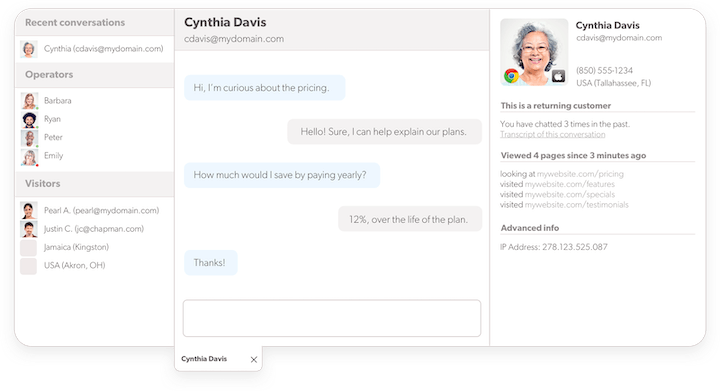
Olark has been making live chat software for years. Previously, they only made software for human agents, but they started offering an AI-powered chatbot in the last couple of years. The software itself is fairly comparable to others on the list, but what makes Olark unique is that they actually build the chatbot for you.
Their chatbots include a number of automation features like agent-specific routing based on a customer's geolocation and auto tagging of conversations to help you gather data and develop insights. You can also set rules to prioritize chats and send transcripts of a chat based on the criteria you set.
Price: Free trial available. AI features are only available on the Pro plan; pricing is available upon request.
5. ChatBot
Best AI chatbot tool for omnichannel support.
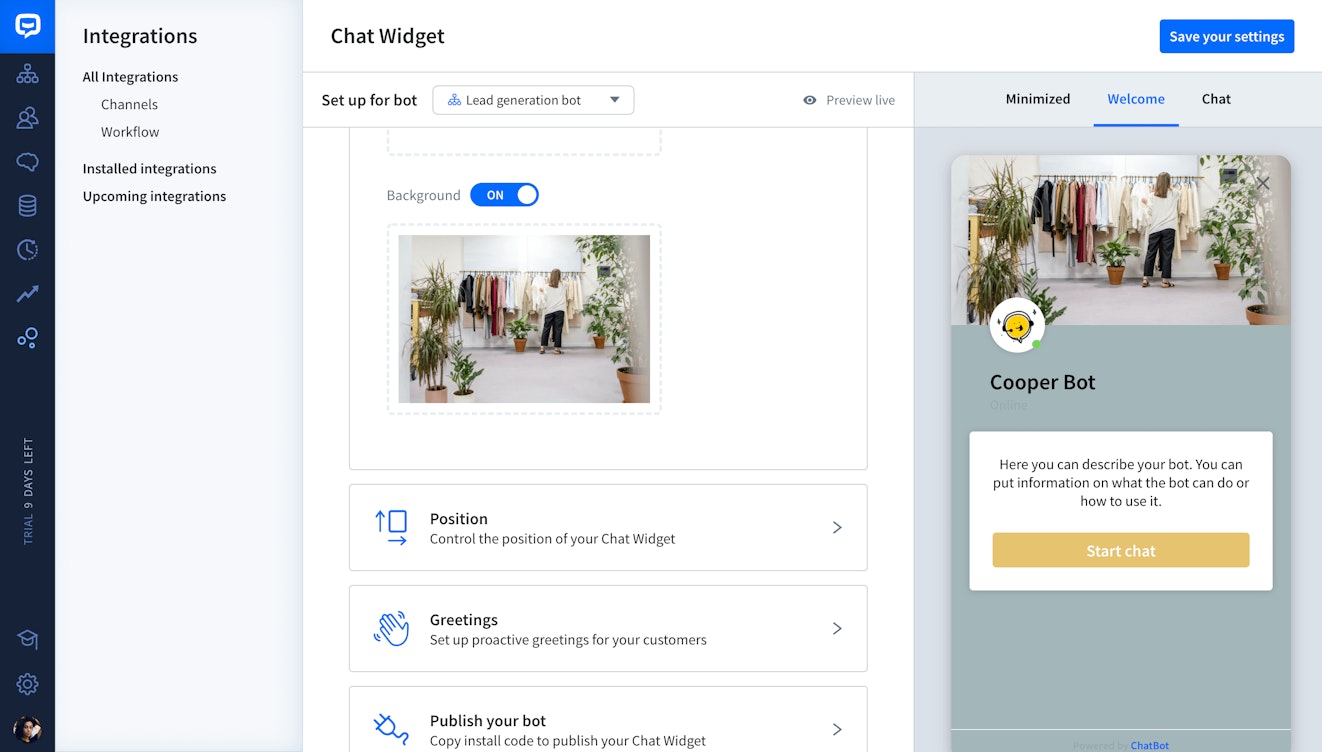
As their name suggests, ChatBot creates chatbot software and has done so for years. They started with logic-based chatbots but have since added an AI-based option as well. Similar to others, ChatBot is trained on the documentation you provide. However, they are unique in a few key ways.
First, they use their own language model and don’t rely on an outside source like ChatGPT. Second, you’re able to use ChatBot for both live chat and with Facebook Messenger and Shopify, so you can deploy the bots in a few different places, which can be useful if you serve audiences on those platforms.
Price: Free trial available. Plans start at $52/month.
Implementing AI live chat
Even though AI is an incredibly complex technology, implementing an AI live chat solution isn’t always a huge lift. We do want to note, though most set up processes are similar to what we outline below, it could vary based on the exact product you purchase. In most cases there are four distinct steps:
Initial sign up.
Training the AI.
Connecting to a language learning model (LLM).
Deploying the bot.
Generally, the first step is to sign up for an AI live chat tool. Some companies offer it as a stand-alone product, where others might only offer it as an add-on feature. The next step is to train it on existing information and documentation you have about your company, product, and services.
This can happen in a few ways depending on what tool you choose:
Upload documents.
Website scraping.
API integration.
Once this step is done and the AI is trained on your company, products, and services, you’ll most likely need to connect to an outside program like ChatGPT or Bard. This is generally done through an API and is what powers the responses and allows the AI live chat program to send replies.
For most tools, there will be some sort of setup wizard for this portion, so it shouldn’t be too complicated. That said, it may require some amount of technical aptitude, which is something to keep in mind
After completing that step, the last thing to do is add the chat widget to your site. This is generally done by adding in a code snippet that’s autogenerated by the live chat platform you signed up for. Again, this doesn’t require you to be able to write code, but it does require some technical aptitude.
Once that’s all done, you should be good to go!
Moving forward
As AI continues to advance, so do the potential business applications of the technology. Embracing things like AI live chat has a lot of upsides, but it’s something that requires a thoughtful approach. As a famous uncle once said, “With great power comes great responsibility.”
So, make sure you fully understand how you’re going to leverage the tech before diving in. Due your due diligence to ensure you’re deploying AI technology in a way that’s useful for both your team and customers.


